List of Solar System objects by greatest aphelion
This article needs to be updated. (January 2020) |
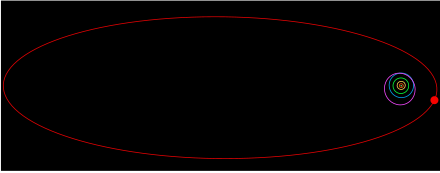
This is a list of Solar System objects by greatest aphelion or the greatest distance from the Sun that the orbit could take it if the Sun and object were the only objects in the universe. It is implied that the object is orbiting the Sun in a two-body solution without the influence of the planets, passing stars, or the galaxy. The aphelion can change significantly due to the gravitational influence of planets and other stars. Most of these objects are comets on a calculated path and may not be directly observable.[1] For instance, comet Hale-Bopp was last seen in 2013 at magnitude 24[2] and continues to fade, making it invisible to all but the most powerful telescopes.
The maximum extent of the region in which the Sun's gravitational field is dominant, the Hill sphere, may extend to 230,000 astronomical units (3.6 light-years) as calculated in the 1960s.[3] But any comet currently more than about 150,000 AU (2 ly) from the Sun can be considered lost to the interstellar medium. The nearest known star is Proxima Centauri at 269,000 AU (4.25 ly),[4] followed by Alpha Centauri at about 4.35 light years.[4]
Oort cloud comets orbit the Sun at great distances, but can then be perturbed by passing stars and the galactic tides.[5] As they come into or leave the inner Solar System they may have their orbit changed by the planets, or alternatively be ejected from the Solar System.[5] It is also possible they may collide with the Sun or a planet.[5]
Neso (the outermost moon of Neptune) takes 27 years to orbit Neptune, comets can take up to 30 million years to orbit the Sun, and the Sun orbits the Milky Way in about 230 million years (a galactic year).
| Satellite | Orbital period (years) |
Parent body | Percentage of parent body orbital period |
|---|---|---|---|
| Neso | 26.7 | Neptune | 16% |
| Oort cloud comet | 30 million | Sun | 13% |
| Sun | 230 million | Milky Way | N/A |
Explanation[]
Barycentric vs heliocentric orbits[]

As many of the objects listed below have some of the most extreme orbits of any objects in the Solar System, describing their orbit precisely can be particularly difficult and sensitive to the time the orbit is defined at. For most objects in the Solar System, a heliocentric reference frame (relative to the gravitational center of the Sun) is sufficient to explain their orbits. However, as the orbits of objects become closer to the Solar System's escape velocity, with long orbital periods on the order of hundreds or thousands of years, a different reference frame is required to describe their orbit: a barycentric reference frame. A barycentric reference frame measures the asteroid's orbit relative to the gravitational center of the entire Solar System, rather than just the Sun. Mostly due to the influence of the outer gas giants, the Solar System barycenter varies by up to twice the radius of the Sun.
This difference in position can lead to significant changes in the orbits of long-period comets and distant asteroids. Many comets have hyperbolic (unbound) orbits in a heliocentric reference frame, but in a barycentric reference frame have much more firmly bound orbits, with only a small handful remaining truly hyperbolic.
Eccentricity and Vinf[]
The orbital parameter used to describe how non-circular an object's orbit is, is eccentricity (e). An object with an e of 0 has a perfectly circular orbit, with its perihelion distance being just as close to the Sun as its aphelion distance. An object with an e of between 0 and 1 will have an elliptical orbit, with, for instance, an object with an e of 0.5 having a perihelion twice as close to the Sun as its aphelion. As an object's e approaches 1, its orbit will be more and more elongated before, and at e=1, the object's orbit will be parabolic and unbound to the Solar System (i.e. not returning for another orbit). An e greater than 1 will be hyperbolic and still be unbound to the Solar System.
Although it describes how "unbound" an object's orbit is, eccentricity does not necessarily reflect how high an incoming velocity said object had before entering the Solar System (a parameter known as Vinfinity, or Vinf). A clear example of this is the eccentricities of the two known Interstellar objects as of October 2019, 1I/'Oumuamua. and 2I/Borisov. 'Oumuamua had an incoming Vinf of 26.5 kilometres per second (59,000 mph), but due to its low perihelion distance of only 0.255 au, it had an eccentricity of 1.200. However, Borisov's Vinf was only slightly higher, at 32.3 km/s (72,000 mph), but due to its higher perihelion distance of ~2.003 au, its eccentricity was a comparably higher 3.340. In practice, no object originating from the Solar System should have an incoming heliocentric eccentricity much higher than 1, and should rarely have an incoming barycentric eccentricity of above 1, as that would imply that the object had originated from an indefinitely far distance from the Sun.
Orbital epochs[]
Due to having the most eccentric orbits of any Solar System body, a comet's orbit typically intersects one or more of the planets in the Solar System. As a result, the orbit of a comet is frequently perturbed significantly, even over the course of a single pass through the inner Solar System. Due to the changing orbit, it's necessary to provide a calculation of the orbit of the comet (or similarly orbiting body) both before and after entering the inner Solar System. For example, Comet ISON was ~312 au from the Sun in 1600, and its remnants will be ~431 au from the Sun in 2400, both well outside of any significant gravitational influence from the planets.
Comets with greatest aphelion (2 body heliocentric)[]


| Object | Heliocentric[1] Aphelion (Q) (Sun) Perihelion epoch |
Barycentric Aphelion (AD) (Sun+Jupiter) epoch 2200 |
Barycentric Aphelion epoch 1800 |
|---|---|---|---|
| C/2004 R2 (ASAS) | 3,238,164 AU (51 ly) | 13000 AU[6] | 4000 AU |
| C/2015 O1 (PANSTARRS) | 1,302,400 AU (21 ly) | 15000 AU[7] | 60000 AU |
| C/2012 S4 (PANSTARRS) | 504,443 AU (8.0 ly) | 5700 AU | 8500 AU |
| (MOSS) | 279,825 AU (4.4 ly) | 7283 AU | 26000 AU |
| (Chen-Gao) | 203,253 AU (3.2 ly) | 3822 AU | 520 AU |
| C/1992 J1 (Spacewatch) | 226,867 AU (3.6 ly) | 3700 AU | 75000 AU |
| C/2007 N3 (Lulin) | 144,828 AU (2.3 ly) | 2419 AU | 64000 AU |
| (PANSTARRS) | 117,212 AU (1.9 ly) | 2975 AU | 84000 AU |
| (Finsler) | 115,031 AU (1.8 ly) | 7121 AU | 16000 AU |
| (Araya) | 108,011 AU (1.7 ly) | 5630 AU | 4200 AU |
| (PANSTARRS) | 80,260 AU (1.3 ly) | 12841 AU | 19000 AU |
| (PANSTARRS) | 77,092 AU (1.2 ly) | 21753 AU | 52000 AU |
| (LINEAR) | 76,230 AU (1.2 ly) | ejection | 98000 AU |
| (NEAT) | 57,793 AU (0.91 ly) | ejection | 59000 AU |
| (Burnham) | 46,408 AU (0.73 ly) | 1110 AU | 7800 AU |
| (Sorrells) | 37,825 AU (0.60 ly) | 8946 AU | 5400 AU |
| (LINEAR) | 37,498 AU (0.59 ly) | 40572 AU | 110000 AU |
| (Christensen) | 35,975 AU (0.57 ly) | 8212 AU | 5300 AU |
| (Boattini) | 31,059 AU (0.49 ly) | 3847 AU | 4200 AU |
| (McNaught) | 26,779 AU (0.42 ly) | 6851 AU | 33000 AU |
| (LINEAR) | 26,433 AU (0.42 ly) | 2480 AU | 75000 AU |
| (NEAT) | 26,340 AU (0.42 ly) | ejection | 4900 AU |
| (Catalina) | 25,609 AU (0.40 ly) | 21094 AU | 12000 AU |
| (Perrine) | 25,066 AU (0.40 ly) | 2306 AU | 74000 AU |
| (Barnard) | 24,784 AU (0.39 ly) | 1575 AU | 2100 AU |
| (Spacewatch) | 24,383 AU (0.39 ly) | 16835 AU | 22000 AU |
Distant periodic comets with well-known aphelion[]
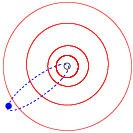
These can also change significantly such as if perturbed by Jupiter
- 153P/Ikeya–Zhang (0.5–102)
- 273P/Pons–Gambart (0.8–63)
- 35P/Herschel–Rigollet[8] (0.7–57 AU, returns in 2092)
- Comet Swift–Tuttle[8] (0.96-51 AU)
- 177P/Barnard (1–47)
- Halley's Comet[8] (0.59-35, for many years the most distant aphelion known)
- 165P/LINEAR (7–29)
- 122P/de Vico (0.6–34)
- 12P/Pons–Brooks (0.7–33.5)
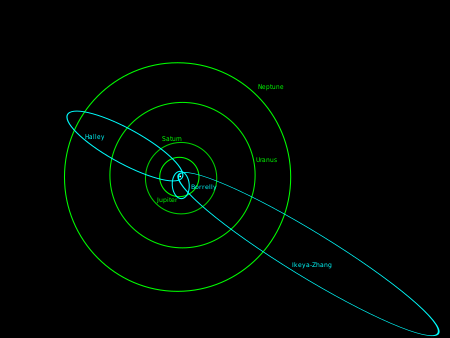
Distant comets with long observation arcs and/or barycentric[]

Examples of comets with a more well-determined orbit. Comets are extremely small relative to other bodies and hard to observe once they stop outgassing (see Coma (cometary)). Because they are typically discovered close to the Sun, it will take some time even thousands of years for them to actually travel out to great distances. The Whipple proposal might be able to detect Oort cloud objects at great distances, but probably not a particular object.
- Comet West 70,000 AU[9] (1.1 light-years)
- C/1999 F1 (Catalina) 66,600 AU[10] (1.05 light-years)
- C/2012 S4 (PANSTARRS) 5700 AU (barycentric)[11]
- Comet Hyakutake (C/1996 B2) 3410 AU[12]
- C/1910 A1 (Great January comet) about 2974 AU (barycentric)[13]
- C/1992 J1 (Spacewatch) 3650 AU[14]
- C/2007 N3 (Lulin) 2400[15]
Minor planets[]
A large number of trans-Neptunian objects (TNOs) – minor planets orbiting beyond the orbit of Neptune – have been discovered in recent years. Many TNOs have orbits with an aphelion (farthest distance to the Sun) far beyond Neptune's orbit at 30.1 AU. Some of these TNOs with an extreme aphelion are detached objects such as 2010 GB174, which always reside in the outermost region of the Solar System, while for other TNOs, the extreme aphelion is due to an exceptionally high eccentricity such as for 2005 VX3, which orbits the Sun at a distance between 4.1 (closer than Jupiter) and 2200 AU (70 times farther from the Sun than Neptune). The following is a list of TNOs with the largest aphelion in descending order.[16][17]
| Aphelion in AU |
Number of minor planets |
|---|---|
| 200–300 | 29
|
| 300–400 | 14
|
| 400–500 | 7
|
| 500–600 | 8
|
| 600–700 | 3
|
| 700–800 | 4
|
| 800–900 | 3
|
| 900–1000 | 2
|
| 1000–1500 | 4
|
| Beyond 1500 | 8
|
TNOs with an aphelion larger than 200 AU[]
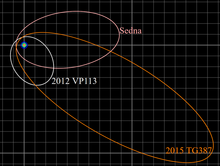
The following group of bodies have orbits with an aphelion above 200 AU,[16] with 1-sigma uncertainties given to two significant digits.
- 2017 MB7 6082 ±282
- 2014 FE72 3390 ±1400
- 2012 DR30 3248.7 ±7.5
- 2005 VX3 2081 ±430
- 2013 BL76 2064.1 ±5.1
- 541132 Leleākūhonua 2037 ±340
- 2015 KG163 1612 ±12
- (308933) 2006 SQ372 1547 ±2[18]
- 2013 SY99 1297 ±41
- 2002 RN109 1126 ±49
- 2013 AZ60 1062.00 ±0.49
- (87269) 2000 OO67 1000.3 ±3.8
- 990 ±130[16][17]
- (523622) 2007 TG422 902.29 ±0.44
- 90377 Sedna 890.5 ±1.1
- 2015 BP519 863 ±1[19]
- 822 ±230
- 2015 RX245 778 ±63
- 2010 BK118 772.20 ±0.46
- 747 ±23
- (418993) 2009 MS9 707.17 ±0.22
- 2010 GB174 671 ±46
- 2013 RF98 665 ±22
- 2015 GT50 626.7 ±5.6
- (474640) 2004 VN112 583.6 ±3.2[20][21]
- 2013 FT28 582 ±20
- (336756) 2010 NV1 570.76 ±0.18
- 560 ±56
- 2014 SR349 545 ±33
- 532.13 ±0.29
- (523719) 2014 LM28 524.28 ±0.14
- 1996 PW 500.56 ±0.64
- 444 ±4000
- 2012 VP113 431.2 ±2.3
- 421.47 ±0.08
- (82158) 2001 FP185 419.14 ±0.12
- 2015 RY245 414.5 ±7.7
- 2002 GB32 402.41 ±0.99
- (148209) 2000 CR105 398.1 ±1.1
- 377 ±130
- 372.37 ±0.17
- 2013 FS28 360 ±180
- 2003 SS422 360 ±270
- 352.6 ±2.6
- (505478) 2013 UT15 347.5 ±1.4
- 346.89 ±0.13
- (468861) 2013 LU28 342.26 ±0.22
- 2007 VJ305 342.13 ±0.30
- 328.97 ±0.75
- 328 ±2300
- (469750) 2005 PU21 313.15 ±0.12
- 2013 UH15 305 ±15
- (506479) 2003 HB57 294.2 ±1.2
- (508338) 2015 SO20 290.51 ±0.07
- 2015 KH163 274.4 ±1.0
- 272.23 ±0.13
- (496315) 2013 GP136 269.08 ±0.33
- 2005 RH52 266.30 ±0.35
- 265.97 ±0.15
- (445473) 2010 VZ98 265.88 ±0.04
- 263.03 ±0.22
- 256.59 ±0.10
- 247.08 ±0.17
- 245.09 ±0.17
- 2014 SS349 243 ±24
- 239.99 ±0.15
- 234 ±2900
- (353222) 2009 YD7 230.54 ±0.08
- 230 ±16
- 226.99 ±0.12
- 2015 KE172 222.11 ±0.11
- (54520) 2000 PJ30 222.0 ±1.9
- 219.26 ±0.10
- (523718) 2014 KZ101 218.84 ±0.02
- 217.24 ±0.09
- 2018 VG18 208.5
- (523726) 2014 MJ70 205.51 ±0.04
- (181902) 1999 RD215 204.83 ±0.24
- 204.6 ±1.5
- 204.35 ±0.49
- (523778) 2014 YK50 202.30 ±0.02
- 202.29 ±0.33
- 200 ±"5,500,000 AU (90 ly)"
(lost object w/ 1 day obs arc)
TNOs with an aphelion between 100 and 200 AU[]

The following group of bodies have orbits with an aphelion between 100 and 200 AU.[22]
- 198.71 ±0.11
- 192.58 ±0.13
- (65489) Ceto 186.92 ±0.02
- (303775) 2005 QU182 186.33 ±0.03
- 185.68 ±0.51
- 185.08 ±0.05
- (437360) 2013 TV158 182.86 ±0.02
- (523771) 2014 XP40 182.01 ±0.02
- 179.21 ±0.09
- 2014 UZ224 179 ±16
- (184212) 2004 PB112 177.93 ±0.19
- (29981) 1999 TD10 177.69 ±0.04
- 177.2 ±3.5
- 173.89 ±0.07
- 173.56 ±0.07
- 173.11 ±0.12
- 172.85 ±0.03
- (91554) 1999 RZ215 172.23 ±0.12
- 171.96 ±0.23
- 169.90 ±0.09
- 169.7 ±5.3
- 168.75 ±0.07
- 166 ±23
- 164.26 ±0.09
- 161.22 ±0.03
- 160.36 ±0.03
- 159.95 ±0.03
- 159.57 ±0.89
- 159.38 ±0.01
- 157.73 ±0.10
- 157.43 ±0.09
- 157.12 ±0.04
- (118702) 2000 OM67 157.08 ±0.20
- 160 ±310
- 2008 ST291 156.40 ±0.34
- 156 ±20
- 155.71 ±0.03
- 155 ±12
- (470593) 2008 LP17 153.25 ±0.02
- (26181) 1996 GQ21 151.76 ±0.02
- 151.0 ±7.5
- (145474) 2005 SA278 149.18 ±0.02
- 149.16 ±0.16
- 148.63 ±0.02
- 148.05 ±0.03
- 148 ±52
- 147.62 ±0.18
- 147.45 ±0.03
- 147.25 ±0.43
- 146.89 ±0.03
- (523698) 2014 GD54 146.82 ±0.02
- (307982) 2004 PG115 144.93 ±0.01
- (145451) 2005 RM43 144.05 ±0.02
- (500832) 2013 GZ136 143.43 ±0.06
- 143.16 ±0.10
- 142.78 ±0.10
- 142 ±20
- (82155) 2001 FZ173 141.82 ±0.08
- 140.17 ±0.06
- 140 ±35
- 140.02 ±0.12
- 138.90 ±0.09
- 137.6 ±1.6
- 137.60 ±0.05
- 137.55 ±0.10
- (523798) 2017 CX33 137.10 ±0.02
- 140 ±290
- 136.55 ±0.14
- (523797) 2016 NM56 136.46 ±0.01
- 2015 TH367 140 ±120
- 136.0 ±2.2
- 135.38 ±0.01
- 100 ±98000
- (523755) 2014 WZ508 132.99 ±0.01
- 132.23 ±0.02
- 131.96 ±0.13
- 100 ±73000
- 131.49 ±0.47
- 100 ±4000000
- 131 ±21
- (15874) 1996 TL66 130.17 ±0.01
- 130.07 ±0.03
- 129.23 ±0.02
- (523794) 2015 RR245 128.62 ±0.03
- 128 ±16
- 127.61 ±0.17
- 127.57 ±0.01
- 126.94 ±0.01
- 125.27 ±0.10
- 125.11 ±0.04
- (523777) 2014 YF50 125.10 ±0.01
- 125 ±79
- 100 ±10000
- (523733) 2014 PR70 124.06 ±0.01
- 124 ±52
- 122.94 ±0.02
- 122.87 ±0.09
- 122.74 ±0.03
- 122.73 ±0.19
- 122.5 ±2.5
- 122.54 ±0.04
- 122.41 ±0.10
- 122.21 ±0.02
- (523767) 2014 WH510 121.42 ±0.01
- 120.94 ±0.06
- 120.43 ±0.02
- 120.42 ±0.04
- 100 ±110000
- 100 ±78000
- 2010 JO179 119.04 ±0.03
- 118.80 ±0.01
- 2003 LA7 118.53 ±0.28
- 117.73 ±0.56
- 117.55 ±0.05
- 117.37 ±0.07
- 117 ±70
- 116.29 ±0.01
- 116.10 ±0.12
- 116.00 ±0.16
- 116.0 ±1.7
- 115.64 ±0.14
- 115.23 ±0.12
- 114.92 ±0.05
- 114.67 ±0.10
- (451657) 2012 WD36 114.32 ±0.08
- 114.06 ±0.04
- 114.04 ±0.80
- 114.02 ±0.13
- (127546) 2002 XU93 113.59 ±0.04
- 112.82 ±0.62
- 111.64 ±0.01
- 111.63 ±0.05
- 111.05 ±0.47
- 110.82 ±0.06
- 111 ±14
- 110.69 ±0.07
- 110.30 ±0.08
- 110.16 ±0.03
- 109.35 ±0.28
- 109.30 ±0.61
- 110 ±150
- 108.70 ±0.06
- 108.68 ±0.06
- 108.67 ±0.06
- 108.61 ±0.03
- 471143 Dziewanna 108.54 ±0.02
- 229762 Gǃkúnǁʼhòmdímà 108.28 ±0.01
- 108.26 ±0.04
- 108.04 ±0.04
- 107.71 ±0.01
- 107.46 ±0.08
- 107.40 ±0.03
- 107.22 ±0.02
- (160148) 2001 KV76 107.11 ±0.18
- 107.09 ±0.03
- 106 ±72
- 106.19 ±0.28
- (65407) 2002 RP120 105.99 ±0.01
- (126619) 2002 CX154 105.83 ±0.10
- 105.43 ±0.06
- (145480) 2005 TB190 104.90 ±0.01
- 104.69 ±0.04
- (523722) 2014 LV28 104.12 ±0.01
- (523680) 2013 YJ151 103.84 ±0.01
- 2014 FC69 104 ±16
- (471272) 2011 FY9 103.64 ±0.02
- (500876) 2013 JD64 103.63 ±0.04
- 104 ±8
- 103.47 ±0.42
- 103.30 ±0.16
- 103.17 ±0.27
- 102.90 ±0.01
- (523770) 2014 XO40 102.64 ±0.01
- 102 ±98
- 100 ±74000
- 101 ±12
- 225088 Gonggong 101.17 ±0.01
- 101.13 ±0.05
- 2014 FC72 101.00 ±0.01
- 100.86 ±0.03
- 100.82 ±0.04
- 100 ±6200
- 100.36 ±0.51
- 100.18 ±0.13
TNOs with an aphelion between 90 and 100 AU[]

- 99.9 ±1.9
- 100 ±2800
- 100 ±72000
- 98.80 ±0.03
- 98.80 ±0.02
- 99 ±25
- 98 ±73
- 100 ±170
- 97.74 ±0.01
- (523652) 2011 LZ28 97.57 ±0.01
- (136199) Eris 97.47 ±0.01
- 96.98 ±0.06
- 96.96 ±0.08
- 100 ±53000
- 100 ±8800
- 96.52 ±0.02
- 2014 FZ71 96.49 ±0.50
- 2006 QH181 96.36 ±0.63
- 96.22 ±0.02
- 95.53 ±0.11
- 95.49 ±0.19
- (470599) 2008 OG19 95.39 ±0.01
- (480017) 2014 QB442 95.32 ±0.01
- (523800) 2017 KZ31 95.23 ±0.01
- 95.08 ±0.03
- 100 ±5300
- 94.88 ±0.03
- (523639) 2010 RE64 94.46 ±0.01
- 100 ±17000
- 93.79 ±0.08
- 93.77 ±0.00
- 94 ±18
- (136120) 2003 LG7 93.56 ±0.11
- (523753) 2014 WV508 93.33 ±0.01
- 93.01 ±0.04
- 92.98 ±0.30
- 92.93 ±0.09
- 92.83 ±0.01
- 92.66 ±0.11
- 92.63 ±0.03
- 90 ±250
- 92.40 ±0.08
- 91.91 ±0.06
- 91.89 ±0.04
- 91.82 ±0.14
- 91.60 ±0.54
- (523787) 2015 DV224 91.38 ±0.01
- 91.27 ±0.05
- 90.97 ±0.13
- 90.94 ±0.02
- 90.91 ±0.01
- 90 ±190
- 90.30 ±0.49
- 90.15 ±0.05
- 90 ±22
Greatest barycentric aphelion[]
The following asteroids have an incoming barycentric aphelion of at least 1000 AU.
| name | absolute magnitude (H) | diameter (km) (assumed) | perihelion (AU) | Heliocentric aphelion (AU) | Barycentric aphelion (AU) (1800) | Barycentric aphelion (AU) (2200) | Change (%) |
|---|---|---|---|---|---|---|---|
| A/2020 M4 | 14.1 | 5.2 | 5.95 | 9990 | 5580 | 4500 | -24 |
| 2014 FE72 | 6.1 | 206.8 | 36.33 | 2970 | 3071 | 3060 | -0.36 |
| 2002 RN109 | 15.3 | 3.0 | 2.691 | 1090 | 2320 | 1190 | -49 |
| 2005 VX3 | 14.1 | 5.2 | 4.106 | 1830 | 2140 | 1700 | -17 |
| 541132 Leleākūhonua | 5.5 | 272.6 | 65.08 | 2120 | 2280 | 2280 | 0 |
| 2017 MB7 | 14.1 | 5.2 | 4.456 | 6080 | 2040 | 2840 | +28 |
| 2012 DR30 | 7.1 | 130.5 | 14.57 | 3190 | 2000 | 2050 | +2.4 |
| 2013 BL76 | 10.8 | 23.7 | 8.355 | 1920 | 1850 | 1920 | +3.6 |
| (308933) 2006 SQ372 | 7.8 | 94.5 | 24.14 | 1780 | 1540 | 1560 | +1.3 |
| 2013 SY99 | 6.7 | 156.8 | 50.03 | 1330 | 1410 | 1410 | 0 |
| 2015 KG163 | 8.2 | 78.6 | 40.50 | 1630 | 1320 | 1320 | 0 |
| 2013 AZ60 | 10.3 | 29.9 | 7.927 | 960 | 1260 | 827 | -34 |
| 14.9 | 3.6 | 2.677 | 970 | 1190 | 852 | -28 | |
| 8.2 | 78.6 | 23.52 | 1330 | 1130 | 1120 | -0.9 | |
| (87269) 2000 OO67 | 9.2 | 49.6 | 20.73 | 1040 | 1120 | 1070 | -4.5 |
Comparison[]
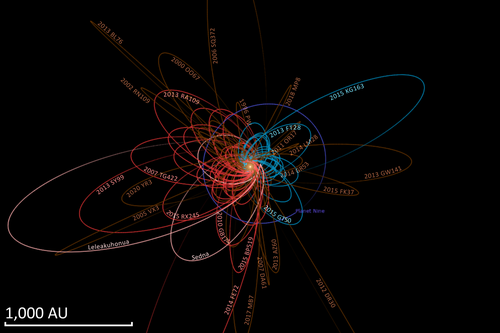
See also[]
- List of trans-Neptunian objects (numbered minor planets only)
- List of unnumbered trans-Neptunian objects
- List of artificial objects leaving the Solar System
- List of Solar System objects most distant from the Sun (then-year distance from the Sun)
- List of nearest stars
- List of the most distant astronomical objects
- About comets
- List of hyperbolic comets
- List of comets with no meaningful orbit
- List of non-periodic comets
- List of periodic comets
- List of numbered comets
- Interstellar comet
- Objects of interest
- 1996 PW
- C/2015 ER61
- C/1980 E1
- 15760 Albion
- Others
References[]
- ^ a b JPL Small-Body Database Search Engine: Q > 20000 (au)
- ^ "C/1995 O1 (Hale-Bopp)". Minor Planet Center. Retrieved 14 March 2018.
- ^ Chebotarev, G.A. (1964), "Gravitational Spheres of the Major Planets, Moon and Sun", Soviet Astronomy, 7 (5): 618–622, Bibcode:1964SvA.....7..618C
- ^ a b NASA – Imagine the Universe: The Nearest Star
- ^ a b c Frequently Asked Questions About General Astronomy
- ^ Barycentric solution for 2004 R2
- ^ Barycentric solution for 2015 O1
- ^ a b c Furthest SSB
- ^ Horizons output. "Barycentric Osculating Orbital Elements for Comet C/1975 V1-A (West)". Retrieved 2011-02-01. (Solution using the Solar System Barycenter. Select Ephemeris Type:Elements and Center:@0)
- ^ Horizons output. "Barycentric Osculating Orbital Elements for Comet C/1999 F1 (Catalina)". Retrieved 2011-03-07. (Solution using the Solar System Barycenter and barycentric coordinates. Select Ephemeris Type:Elements and Center:@0)
- ^ Horizons output. "Barycentric Osculating Orbital Elements for Comet C/2012 S4 (PANSTARRS)". Retrieved 2015-09-26. (Solution using the Solar System Barycenter and barycentric coordinates. Select Ephemeris Type:Elements and Center:@0)
- ^ Horizons output (2011-01-30). "Barycentric Osculating Orbital Elements for Comet Hyakutake (C/1996 B2)". Retrieved 2011-01-30. (Horizons)
- ^ Horizons output. "Barycentric Osculating Orbital Elements for Comet C/1910 A1 (Great January comet)". Retrieved 2011-02-07. (Solution using the Solar System Barycenter and barycentric coordinates. Select Ephemeris Type:Elements and Center:@0)
- ^ Horizons output. "Barycentric Osculating Orbital Elements for Comet C/1992 J1 (Spacewatch)". Retrieved 7 October 2012. (Solution using the Solar System Barycenter and barycentric coordinates. Select Ephemeris Type:Elements and Center:@0)
- ^ Horizons output. "Barycentric Osculating Orbital Elements for Comet Lulin (C/2007 N3)". Retrieved 2011-01-30. (Solution using the Solar System Barycenter. Select Ephemeris Type:Elements and Center:@0)
- ^ a b c JPL asteroids greater than 200 AU aphelion (Q)
- ^ a b JPL asteroids aphelion greater than 800 AU
- ^ Marc W. Buie. "Orbit Fit and Astrometric record for 308933" (2010-09-17 using 64 of 65 observations over 5.01 years). SwRI (Space Science Department). Retrieved 2008-09-05.
- ^ Becker, J. C; et al. (14 May 2018). "Discovery and Dynamical Analysis of an Extreme Trans-Neptunian Object with a High Orbital Inclination". The Astronomical Journal. 156 (2): 81. arXiv:1805.05355. doi:10.3847/1538-3881/aad042. S2CID 55163842.
- ^ Marc W. Buie (2007-11-08). "Orbit Fit and Astrometric record for 04VN112". SwRI (Space Science Department). Archived from the original on 2010-08-18. Retrieved 2008-07-17.
- ^ "JPL Small-Body Database Browser: (2004 VN112)". Retrieved 2011-05-20.
- ^ JPL database down to 100 AU aphelion minor planets
External links[]
- Lists of Solar System objects